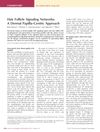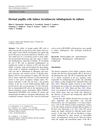Number Changes and Development Potential of Wool Follicle Cells in the Early Stages of Fiber Differentiation
September 1982
in “
Journal of ultrastructure research
”
TLDR Wool follicle cells are more complex than previously thought.
The study from 1982 reported on the early stages of fiber differentiation in wool follicles, highlighting the complexity of cell movement and incorporation into fibers. It identified new cellular features in the bulb and dermal papilla, such as mast cells, specialized basal lamina, hemidesmosomes, and primary cilia, which indicated a more intricate bulb-dermal papilla function than previously understood. These findings suggested a sophisticated system of cell supply and integration during wool fiber development.



